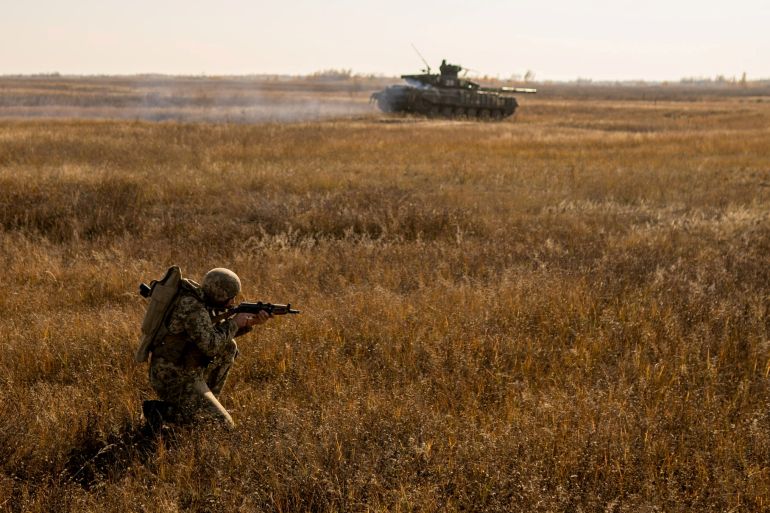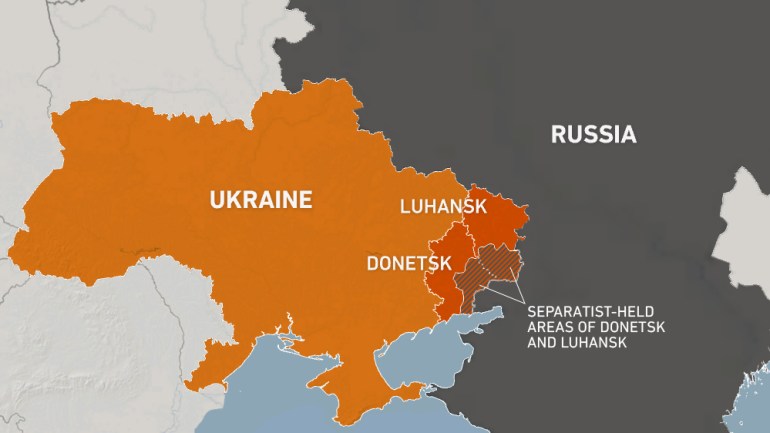How real is the threat of a Russian invasion of Ukraine?
Experts are divided on whether Moscow is planning an imminent incursion, or merely posturing to win geopolitical sway.

Kyiv, Ukraine – As early as January, the Kremlin may unleash a “brief and victorious” war on Ukraine, a top military expert has told Al Jazeera, as world leaders and international bodies weigh the possibility of such a conflict.
Russian President Vladimir Putin wants his troops to reach the Dnieper River that dissects Ukraine, seize a land corridor to annexed Crimea and ensure the resumption of water supply to the arid peninsula that was cut off in 2014 causing a chronic drought, said Ihor Romanenko, a retired lieutenant general and Ukraine’s former deputy chief of staff.
Keep reading
list of 4 itemsBlinken warns Russia of ‘severe costs’ if it invades Ukraine
Belarus’s Lukashenko says annexed Crimea is legally Russian
What triggered tension between Ukraine and Russia?
The blitzkrieg will not just involve tens of thousands of Russian servicemen currently deployed to the border with Ukraine, which is east of the capital Kyiv, and to Crimea, which is south of mainland Ukraine, he said.
It may include an invasion of Russian troops from Moscow-friendly Belarus, which is north of Kyiv, and Transdnistria, a breakaway, pro-Moscow Moldovan region stretches across Ukraine’s southwestern border, he said.
“The most effective way is to begin military action from all sides simultaneously,” Romanenko told Al Jazeera.

Ukrainian officials say that Russia amassed up to 115,000 troops near its borders in recent weeks.
According to Romanenko, there could also be domestic “provocations” that involve disgruntled oligarchs, pro-Kremlin politicians and a sizeable number of Russian-speaking Ukrainians in Ukraine’s east and south – while Moscow stops the supply of natural gas that heats almost every Ukrainian house and apartment building.
Last week, Ukrainian President Volodymyr Zelenskyy claimed that his nation’s richest oligarch Rinat Akhmetov was “being dragged” into an alleged coup to overthrow the government.
Akhmetov denied the allegations.
‘Hysteria’
If a serious conflict breaks out, a third of Ukraine, a France-sized nation of 43 million, would be affected – and war would have to be quick, no longer than a month, to avoid public dissatisfaction in Russia, Romanenko said.
And even though many Western nations pledged to help Ukraine with weaponry, Ukrainians “understand that no one will fight for us,” Romanenko concluded.
Some in the West agree.
United States Secretary of State Antony Blinken warned Moscow about “severe costs and consequences” after meeting his Russian counterpart Sergey Lavrov in Sweden on Thursday.
He said US President Joe Biden may meet with Putin in the nearest future “to speak directly.”
The first and so far, only Biden – Putin summit took place in June, less than two months after Russia scaled back a previous build-up of more than 100,000 troops on the Ukrainian border.
But a few months later, Western and Ukrainian fears of Russian “aggression” resurged.
In late November, US intelligence warned their European Union counterparts about the possibility of Russia’s “rapid, large-scale push” into Ukraine from multiple locations, Bloomberg reported.
The Kremlin dismissed the claims.
“This hysteria is created artificially,” Kremlin spokesman Dmitri Peskov told reporters on November 21. “This is not very logical and not very decent.”
Pro-Kremlin observers claim that the “hysteria” helps the Ukrainian president overcome his plummeting approval ratings and stifle critics.
“By pumping fear, Zelenskyy’s team is trying to get additional resources to fight opposition, dissidents,” Dmitry Perlin told Radio Sputnik on Thursday, adding that Ukraine “must think twice, even thrice, before making military decisions” to counter Russia.
Upping the ante?
Other experts disagree with the invasion scenario and say Putin is simply bluffing to force the West – especially the US – to be more attentive to his demands.
“We’re not talking about an invasion but about a generation of uncertainty, of geopolitical entropy to achieve a critical mass to coerce the West to start the new Yalta talks with Russia,” Kyiv-based analyst Aleksey Kushch told Al Jazeera.
He was referring to the 1945 conference in the southern Crimean city between the Soviet leader Josef Stalin, UK Prime Minister Winston Churchill and US President Franklin D Roosevelt.
The conference carved up the post-World War II world turning Eastern European nations into Soviet vassals.
These days, Moscow sees its ties to Ukraine as part of its broader, spiralling confrontation with the West – and NATO’s eastwards expansion to Russia’s former back yard.
“Russia talks about red lines, but implies Western guarantees of non-deployment of troops and arms in Ukraine, which is equal to admitting that Ukraine is the area of special, if not exclusive, interests of Russia,” Pavel Luzin, a Russia-based defence analyst with the Jamestown Foundation, a think-tank in Washington, DC, told Al Jazeera.
Putin claims the West ignores Russia’s “red lines” by holding drills in the Black Sea and dispatching sophisticated arms to Kyiv.
He has demanded “legal guarantees” that NATO would not accept Ukraine as a member.
“We will never allow our historical territories and people close to us living there to be used against Russia,” Putin wrote in an article in July, reiterating his claim that Russians and Ukrainians are “one people.”
Economy crushed?
If an invasion took place, the West would inevitably slap sanctions on Russia – and both moves would harm Russia’s economy.
It would be “suicidal” for Russia to start the invasion because the US and the EU will stop buying Russia’s hydrocarbons and fertiliser and will give up on Nord Stream 2, a brand new natural gas pipeline to Germany that awaits certification, Nikolay Mitrokhin of Germany’s Bremen University said.
Russia will lose two-thirds of its foreign trade revenues, while US energy companies will reanimate their shale oil and liquefied natural gas projects to compensate for the lost exports from Russia, he said.
“The very existence of Putin’s regime that stands on oil exports will be in question,” Mitrokhin told Al Jazeera.
Another important factor is the revival of Ukraine’s military might.
In 2014, Ukrainian troops were under-equipped and demoralised, when pro-Russian separatists in the southeastern regions of Donetsk and Luhansk took up arms against Kyiv carving out two totalitarian, economically stillborn “People’s Republics”.
But seven years later, as the trench war against the separatists smouldered, Ukraine’s military is battle-trained – and equipped with better weaponry, produced domestically or supplied by the West or Turkey.
“Putin is artificially spiralling the degree of hysteria because Moscow realised that the Ukrainian military is irreversibly re-arming with all the US, Turkish and, soon, German supplies, and won’t be so critically weak in the face of the Russian invasion with conventional weapons,” Mitrokhin said.